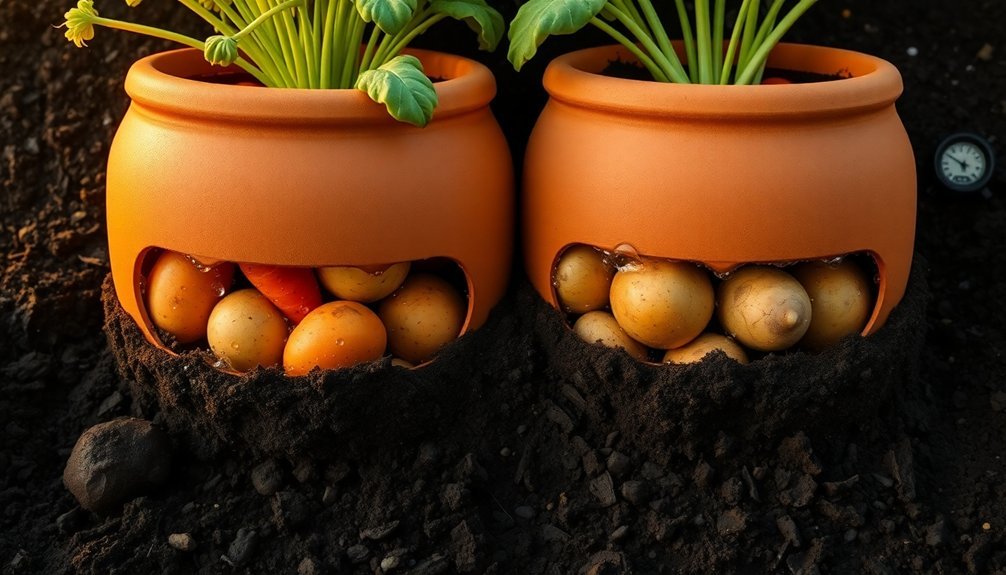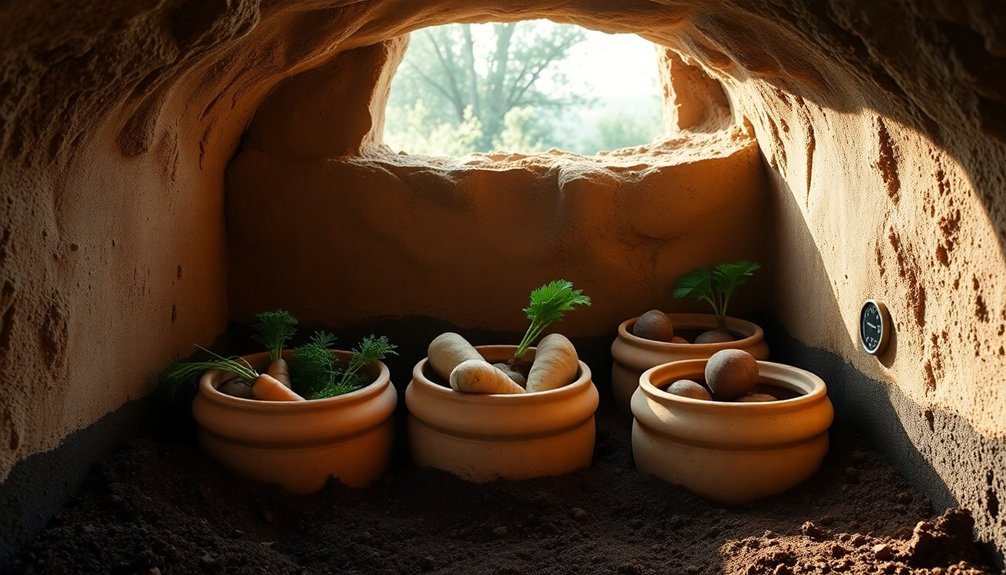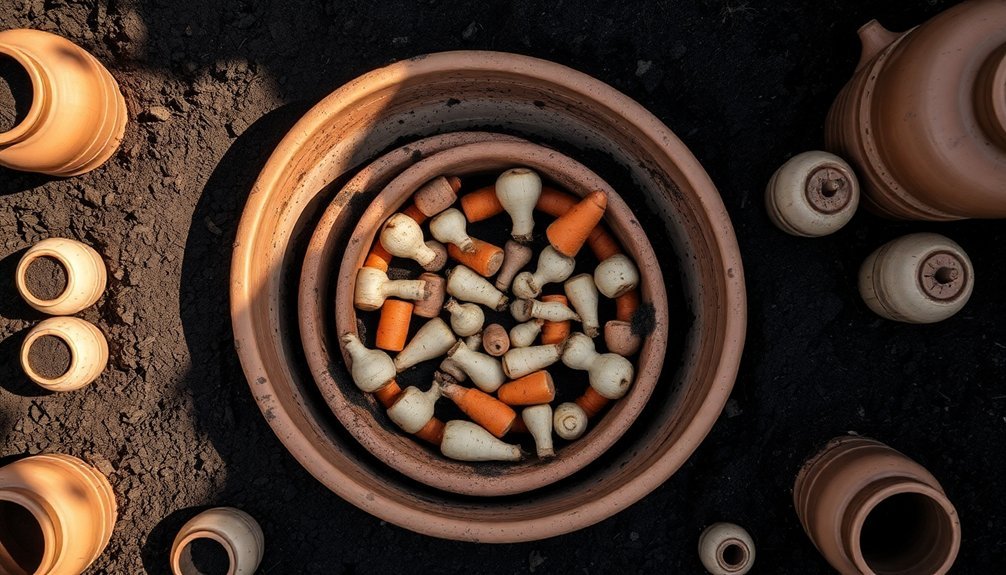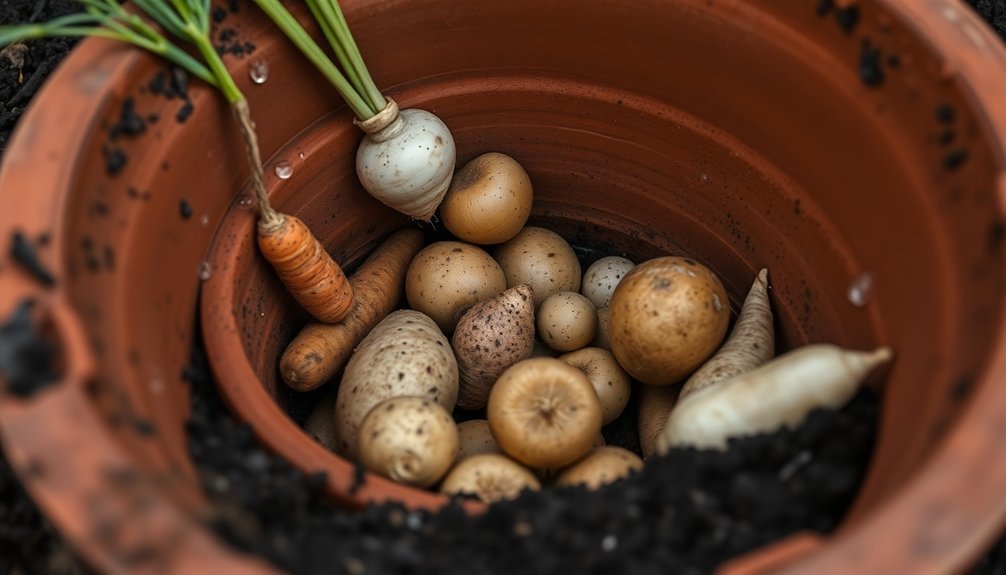Storing root vegetables in clay pots underground offers a natural, energy-free preservation method that can keep your harvest fresh for up to six months. The porous clay material works like a natural refrigerator, using evaporative cooling to maintain temperatures 10°C below ambient conditions. You'll benefit from ideal humidity levels above 90% as the clay regulates moisture naturally, preventing your vegetables from dehydrating or spoiling. When you combine this with proper sand layering and ventilation, you'll create superior storage conditions between 32-40°F. These traditional techniques hold the key to extending your harvest's shelf life without electricity.
Natural Cooling Process Explained

Throughout history, clay pot storage has harnessed the power of evaporative cooling to preserve food naturally. You'll find this method operates much like your body's cooling system when you sweat – as water evaporates from the surface, it draws heat away, creating a natural cooling effect.
When you store vegetables in a clay pot, the porous material allows water to seep through and evaporate from its outer surface, effectively lowering the temperature inside. Unlike freezing methods that require proper blanching times, this traditional storage approach needs no preparation steps.
What makes this system particularly valuable is that you don't need electricity to keep your root vegetables fresh. The process creates an environment that's consistently cooler than the surrounding air, often reaching temperatures up to 10°C below ambient conditions.
As the water evaporates, it also generates humidity inside the pot, which helps prevent your vegetables from drying out.
You'll notice the conditions inside your clay pot storage system mirror those of a crisp autumn day – cool and slightly moist. This natural cooling process works continuously as long as there's water available for evaporation, making it an efficient and sustainable storage solution for your root vegetables.
Root Vegetable Storage Benefits
The remarkable benefits of clay pot storage make it an ideal solution for preserving root vegetables. You'll find that clay pots maintain optimal temperatures between 35-40°F, protecting your vegetables from freezing while preventing sprouting and rotting. This consistent environment guarantees your produce stays fresh and viable for extended periods. Traditional root cellar methods inspired this effective storage approach.
You can expect impressive humidity management when using clay pots. They'll maintain levels above 80%, which is essential for preventing dehydration and maintaining vegetable quality. By adding materials like sand, sawdust, or straw, you'll create favorable conditions that keep your vegetables separate and properly moisturized.
You'll be amazed at how long your vegetables can last in clay pot storage. Your carrots and potatoes can stay fresh for up to six months, while onions can remain viable for up to seven months. Winter squash and other root vegetables will also maintain their quality for extended periods without requiring modern refrigeration.
Best of all, you're choosing an energy-efficient storage method. Clay pot storage doesn't rely on electricity, instead using natural insulation and traditional preservation techniques. It's a sustainable choice that reduces your environmental impact while effectively preserving your harvest.
Ideal Underground Storage Conditions

While clay pots offer excellent storage options, underground storage creates an even more controlled environment for your root vegetables.
You'll want to maintain temperatures between 32-40°F (0-4°C) for most root vegetables, though potatoes need special care with initial storage at 45-60°F before dropping to cooler temperatures for long-term storage.
Your underground storage space should maintain humidity levels above 90% for ideal preservation. You can achieve this by adding sawdust, sand, or straw to reduce surface evaporation. Consider using a frost-free environment like cellars for vegetables that cannot withstand freezing temperatures.
If you're in a dry climate, place a pan of water in your storage area to boost moisture levels.
It's critical to keep your vegetables in complete darkness, as light triggers photosynthesis and speeds up decay.
You'll need to protect your storage area with heavy blankets or other light-blocking materials if you're using a makeshift setup.
Don't forget to install wire mesh barriers to keep rodents out and guarantee proper ventilation to prevent mold growth.
Remember to check your stored vegetables regularly for signs of spoilage and maintain consistent temperatures, as even small variations can trigger sprouting.
Proper organization and rotation will help maintain ideal storage conditions throughout the season.
Clay Pot Selection Guide
Selecting your perfect clay pot setup starts with understanding the basic two-pot system: an inner pot for storing vegetables and a larger outer pot to create the cooling chamber.
You'll need enough space between the pots to fill with sand, which is vital for the evaporative cooling process. While clay pots are traditional, you can also use plastic or metal containers for the inner pot, making this system highly adaptable to your budget and available materials.
When choosing your pots, consider these essential factors:
- Size ratio – Your outer pot must be considerably larger than the inner pot to accommodate both the sand layer and proper airflow, which maintains the cooling effect.
- Storage needs – Match your pot size to the amount of produce you'll typically store, keeping in mind that larger setups require more maintenance and water.
- Accessibility – Select pots that you can easily maintain and check daily, as you'll need to monitor moisture levels and inspect stored vegetables regularly.
Remember to avoid storing high-humidity produce like potatoes and onions in your clay pot system, as these items can lead to premature spoilage.
Instead, focus on vegetables that benefit from the cooler, humid environment, such as carrots and other root vegetables.
Proper Root Vegetable Arrangement

Having the right clay pot setup is just the beginning – proper arrangement of your root vegetables guarantees maximum storage life and freshness.
You'll need to inspect each root carefully before storage, removing any that show signs of damage or imperfection. Don't wash the vegetables; simply twist off the foliage and brush away loose soil.
Arrange your roots in a single layer, making sure they don't touch each other. This separation prevents moisture transfer and reduces the risk of decay spreading. You'll want to pack larger roots first, as they typically store better than smaller ones. Consider freezing, dehydrating, or canning smaller specimens instead.
Place a layer of slightly damp sand or old potting mix between the roots, but don't let it directly contact them. This helps maintain proper humidity while allowing necessary ventilation.
You can add insulating materials like straw or scrunched newspaper around the edges of your clay pot to regulate temperature.
Remember to position your clay pot away from apples and keep it in a dark location. Arrange the roots so you can easily check them periodically and remove any that develop problems.
Essential Maintenance Tips
You'll need to check your stored root vegetables daily to verify the sand layer retains proper moisture levels.
Keep a spray bottle handy to mist the sand when it starts feeling dry, but don't oversaturate it to prevent root rot.
Watch for any water pooling at the bottom of your clay pots, as excess moisture can quickly lead to spoilage of your stored vegetables.
Daily Water Monitoring Tasks
For successful root vegetable storage in clay pots, consistent water monitoring is vital. You'll need to check the moisture level daily, as clay pots can dry out more quickly than other containers.
While you don't want to water too frequently, maintaining uniform soil moisture is essential for preventing root disorders and bitter-tasting vegetables.
To effectively monitor and manage water levels in your clay pots:
- Check the top inch of soil daily by inserting your finger – if it feels dry, it's time to water. Remember, you're aiming to keep the soil moist to a depth of six inches for best root vegetable storage.
- Water deeply but less frequently, providing 1-2 inches of water weekly. This approach encourages deeper root development and helps prevent problems like hairy roots or forking in carrots and parsnips.
- Consider your soil type when monitoring moisture levels, as different soils retain water differently. Confirm you're using well-draining soil to prevent waterlogging, which can lead to rot and spoilage of your stored vegetables.
Watch for signs of moisture fluctuation, and adjust your watering schedule based on your specific root vegetables' needs, keeping in mind that most root vegetables are over 85% water.
Keep Sand Layer Moist
Beyond daily water monitoring, maintaining proper moisture in your sand layer creates a perfect environment for root vegetable storage.
You'll want to verify your sand feels damp to the touch but isn't waterlogged, as this balance mimics natural underground conditions and slows vegetable degradation. When you notice the sand becoming dry, spray it with distilled water to restore ideal moisture levels.
Check your sand's moisture content regularly, especially if you're storing vegetables in a dry room. You can maintain perfect conditions by using clean, fine-grade play sand that's been properly washed and screened.
Don't use sand that contains chemicals or contaminants, as these can affect your vegetables' quality and safety.
Your storage setup should include a 2-inch base layer of slightly moist sand, with vegetables arranged so they don't touch each other. Cover each layer with additional sand until you've completely buried your root vegetables.
If you're using clay pots, they'll help regulate moisture levels naturally, but you'll still need to monitor the sand's dampness weekly.
Remember to keep storage temperatures between 32-40°F with 90-95% relative humidity for best results.
Frequently Asked Questions
How Deep Should Clay Pots Be Buried in Different Soil Types?
You don't need to bury clay pots at all. Instead, keep them above ground in shady, ventilated areas. If you're storing root vegetables, focus on proper sand filling and moisture maintenance between the pots.
Can Multiple Types of Clay Pots Be Stacked Underground?
You can stack different clay pots underground, but you'll need proper alignment and support. Use larger pots as bases, maintain spacing for ventilation, and add straw between layers to prevent damage.
What Indigenous Materials Can Substitute for Traditional Clay Pots?
You can use natural materials like straw-filled buckets, sand-packed wooden boxes, or peat moss-lined containers. Metal trash cans, cardboard boxes with sawdust, and plastic bins with organic bedding work effectively too.
How Do Seasonal Temperature Changes Affect Underground Clay Pot Storage?
You'll find that underground clay pots maintain stable temperatures year-round. In winter, they're protected from freezing, while in summer, they stay cool. The earth's insulation helps control temperature fluctuations naturally.
Will Buried Clay Pots Attract Unwanted Pests or Rodents?
While buried pots can attract pests, you'll minimize this risk by using protective mesh covers, adding natural deterrents like bay leaves, and keeping your storage area clean. Regular inspections help catch issues early.
In Summary
You'll find clay pot underground storage is a time-tested method that perfectly preserves your root vegetables. The natural cooling and humidity control of clay, combined with stable underground temperatures, keeps your harvest fresh for months. Choose the right pot size, arrange your vegetables properly, and maintain ideal moisture levels. With this traditional storage solution, you'll have nutritious root vegetables ready whenever you need them.





Leave a Reply